Rio Hondo College Art Gallery SUR:Biennial 2019
SUR:Biennial > 2019 > Rio Hondo
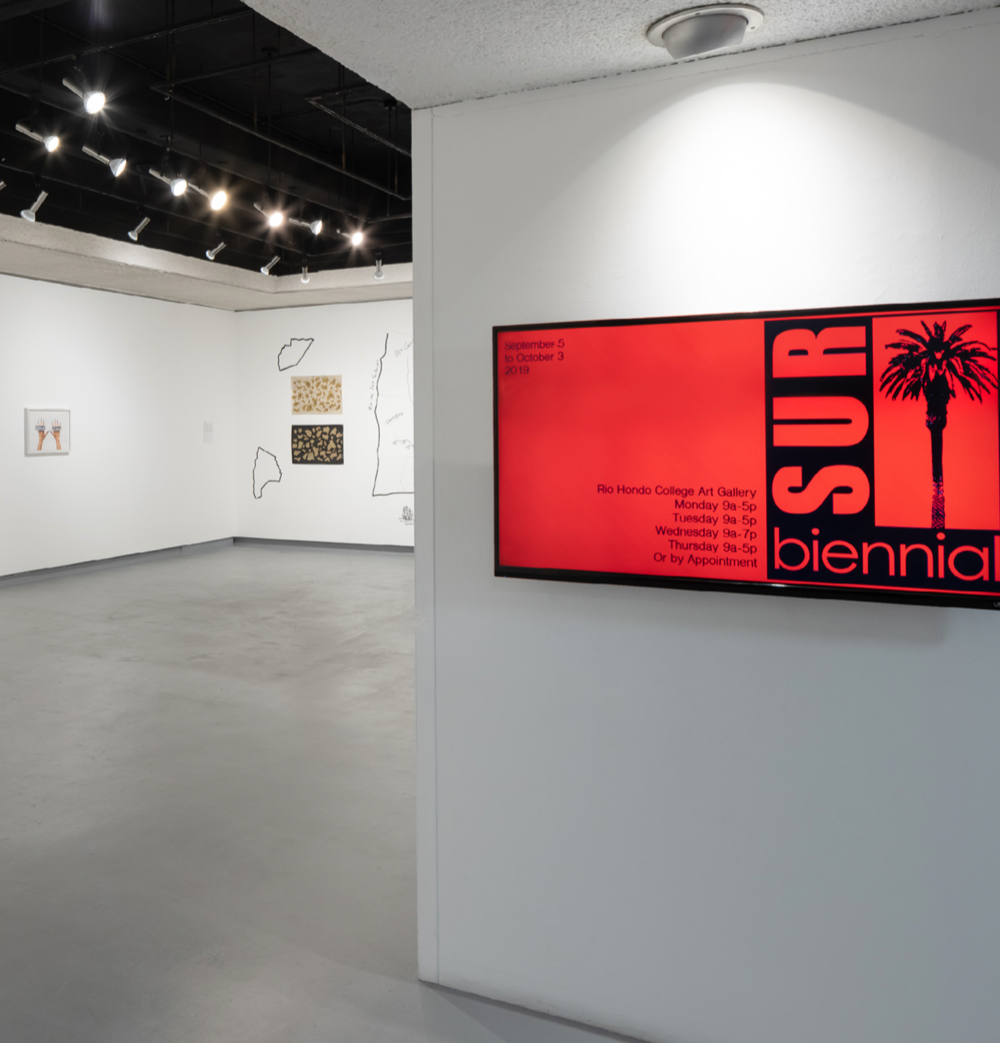
Rio Hondo Art Gallery Installation Shot.
CUENTISTA (STORYTELLER)
Cuentista brings together seven artists that highlight the artist as storyteller through documenting and sharing true accounts of identity, gender, body and place. Approaching from a variety of mediums, each artist carefully documents and explores questions of identity and belonging to tell a story. The stories bear witness to the truth and bring awareness to the issues confronted in the experience. Danielle Cansino’s paintings feature a reimagined narrative of the ever-popular Mexican game, Loteria, that bring the game into a contemporary conversation with recognizable icons. Teresita de la Torre’s selection of drawings welcomes the viewer to read the works like journal entries as it shares a two-fold story - one of an unknown immigrant crossing the border and one of her experience wearing their found tattered shirt for 365 days. Jennifer Ling Datchuk’s photo comes from a series that confronts questions of what makes up the dominant culture, American culture, by referencing a popular catchphrase and trending style aesthetics on an oversized ceramic knuckle ring and a fresh set of acrylic nails, respectively. Manuel López’s series of black and white line drawings are drawn from his experiences and memories of his environment to create a chic and thoughtful love letter to LA. Bringing together techniques of printmaking and collage, Álvaro D. Márquez contrasts original areas of LA with areas of displacement using deep, bold colors, shapes and textures. On the gallery lawn, Sergio Daniel Roleto has constructed a mural with sound that features an image and a looped sound bite from the 1959 film, Inherit The Wind, that looks at how individuals react when their ignorance and integrity is questioned. Jaklin Romine created a fierce installation using iridescent, sheer fabrics on organic forms featuring photographs of her own body’s trauma from living with SCI.
Danielle Cansino, De Donde Eres? (vii - preface), Oil on Panel, 18" x 24", 2016.
Danielle Cansino
My work pertains to the issues of under-represented cultures. My paintings are intended to break the normal standards of traditional painting, by inserting people of different ethnic heritages into the subjects which are usually predominantly White. I want to show the feeling I have of injustices, but also want to exhibit that all are just in search of happiness in life. It gave me the idea to create my own interpretation of these words, especially in the context of my own upbringing and surroundings.
Working with traditional oil painting materials in my undergraduate studies made me explore other surfaces that would directly emphasize the topic of Latino culture, and a blue collar upbringing. I first used Mexican textiles, specifically serapes which are handmade Mexican blankets, to replace canvas. I painted in a way that the textile would peak through around the painting, and could be transparently seen around the work. Given the serape’s utilitarian purpose of warmth and shelter, I used it to create a sense of nostalgia for those of us who recognize them, and to reference hard labor. I also used finished wood surfaces, in the same style of transparency as the serape paintings. The use of raw material gives a feel of craftsmanship, and hints at the natural wood use in Latino furniture, as remembered in my childhood.
The narratives painted on these new surfaces were inspired by the Mexican game, Loteria. The game is very popular in Latino culture, and is very close to bingo— with images instead of letters. These images I chose to paint reflect a modern idea of the original card, and its use in contemporary context.
My artistic intentions are to inspire those around me to celebrate our differences,
to recognize the humanity in everyone, and to take pride in our underrepresented cultures.
My ancestors were native to this land. It was
their home, and it is my home. The beautiful thing about The United States is that
it is made up of so many different cultures, ethnicities, and nationalities. I look
forward to advocating for ideas of unity and acceptance through my practice.
Born in Los Angeles, CA, Danielle Cansino began drawing at a very young age. Though she loved to draw, she was also passionate about other arts such as writ- ing, music, and makeup artistry. While attending Cal State University Long Beach for Creative Writing, she became a makeup artist for major retailers, and went into sales management and industry-level marketing. Through her experience in makeup work, Danielle was inspired to seek out her first passion; and to create work with a connection to her own culture, heritage, and experience. She then adopted painting, drawing and tattooing into her life as a new form of expression. Danielle attended Rio Hondo College, shortly after her first apprenticeship for tattooing in 2013, to hone her drawing skills and specialize in Portrait Realism. In her time there, she was invited to exhibit in the American Museum of Ceramic Art Student Exhibition, the Rio Hondo Gallery Student Show, and Chronos Gallery of Downtown Los Angeles. She was also honored to be awarded Grand and First prize for her 2014 oil paintings, “From Doha with Love” and “Teach Them Young”. In 2017, Danielle graduated Magnum Cum Laude from Laguna College of Art and Design, where She earned a Bachelors of Fine Arts in Drawing and Painting, with an Emphasis in Sculpture. After graduation in 2018 Danielle began tattooing full time as a resident artist at Mi Familia Tattoo Studio, where she specializes in color and black and grey realism. In fall of 2019, Danielle began her candidacy for Masters of Fine Art, attending the University of Southern California.
Jennifer Ling Datchuk
My work has always been an exploration of my layered identity – as a woman, a woman of color, as an “American,” as a third culture kid. I live at the intersection of being neither fully Chinese or Caucasian, a sense of being in-between, seen as an imposter on either side. The constant question about my appearance – So, what are you? – has driven a series of different answers in my work over time. I explore this conflict specifically through porcelain, a nod to my Chinese heritage, but also a representation of “pure” white, a desire reflected in both cultures. Porcelain allows me to speak in dualities, especially of fragility and resilience and ultimately the struggle between diversity and the flawless white body.
Trained and educated traditionally in ceramics, my practice evolved from sculpture to mixed media as I began to focus on domestic objects and the feminine sphere. Handwork and hair both became totems of the small rituals that fix, smooth over, and ground women’s lives. Through these materials, I explore how Western beauty standards influenced the East, how the non-white body is commodified and sold, and how women’s – globally, girls’ – work is still a major economic driver whose workers still struggle for equality. Americans are being confronted with their icons, their fetishes, their appropriations and have a constant desire for authenticity. Most of the objects we access are designed, produced, manufactured, sold, and consumed without conscious knowledge of the source. Working with porcelain, blue and white patterns, stereotypically Asian motifs, textiles, video, and photography allows me to examine what we see as our “dominant” material culture. Bound by these conditions, I stitch together my individual nature, unravel the pressures of conformity, and forever experience pain in search of perfection.
Jennifer Ling Datchuk is an artist born in Warren, Ohio and raised in Brooklyn, New York. Her mother came to this country in the early 1970s from China; her father born and raised in Ohio to Russian and Irish immigrant parents. Beyond initial appearances, the layers of her parents’ past and present histories are extremely overwhelming and complicated – a history of conflict she has inherited and a perpetual source for her work. She captures this conflict by exploring the emotive power of domestic objects and rituals that fix, organize, soothe and beautify our lives. Trained in ceramics, the artist works with porcelain and other materials often associated with traditional women’s work, such as textiles and hair, to discuss fragility, beauty, femininity, intersectionality, identity and personal history. She holds an MFA in Artisanry from the University of Massachusetts Dartmouth and a BFA in Crafts from Kent State University.
She has received grants from the Artist Foundation of San Antonio, travel grant from
Artpace, and
the Linda Lighton International Artist Exchange Program to research the global migrations
of porcelain and blue and white pattern decoration. She was awarded a residency through
the Blue Star Contemporary Art Museum to conduct her studio practice at the Künstlerhaus
Bethanien in Berlin and has participated in residencies at the Pottery Workshop in
Jingdezhen, Vermont Studio Center, European Ceramic Work Center in the Netherlands
and Artpace in San Antonio. In 2017, she received the Emerging Voices award from the
American Craft Council. She is lives and maintains a studio practice in San Antonio,
Texas.
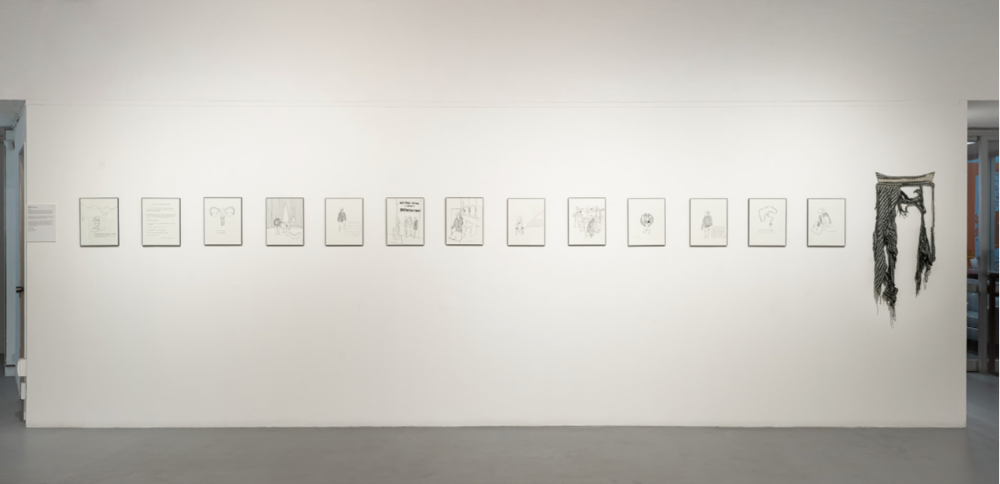
Teresita De La Torre, 365 Days in an Immigrant's Shirt (Year-long Performance) 2019.
Teresita De La Torre
Mexican-born, Texas-raised artist Teresita de la Torre is a multimedia artist from Laredo Texas based in Long Beach who is interested in subverting and ideas of femininity and masculinity through re-thinking her inherited journeys of migration. Her practice has grown from drawing, painting, and photography to embroidery and performance.
Teresita de la Torre through her work publicly invites viewers into a private conversation. Navigating the frauhgt waters of family, culture, tradition, and sexuality. In her Current work. Teresita de la Torre is looking towards subverting masculinity, her interests in family and the broad Latinx migrant community in the effort to complicate gender and its violence.
She is interested in reclaiming her space in her familial history and that of others around her through the work of performance, photographs, and drawings that document histories, struggles, risk, connections, love, dreams, and family.
Teresita de la Torre was born in Guadalajara Mexico and migrated with her family at a young age to Laredo, Texas. In Texas, she received her Bachelor's of Fine Art at Texas A&M International University. Six years ago de la Torre moves to Southern California to pursue her Master's degree of Fine Art at Cal State University Fullerton. De la Torre has exhibited her work in and around Southern California, Texas, Georgia, Tijuana, Taiwan, and Berlin in spaces like Grand Central Art Center, East Int'l (ESXLA), Museum of Design Atlanta, and the Charles White Elementary School Gallery.
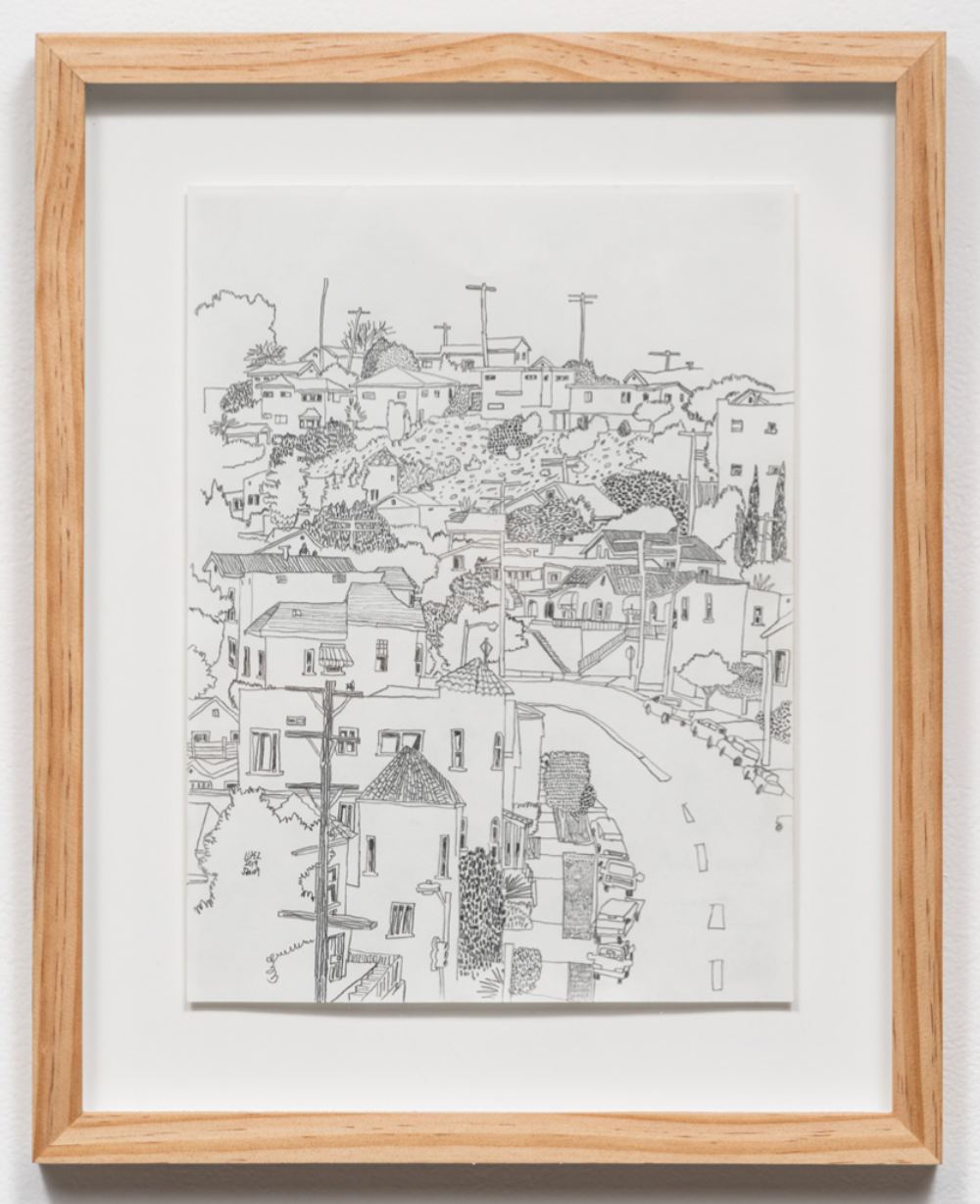
Manuel Lopez, City Terrace (Looking and Drawing, Mostly Looking), Pencil on Paper,
12" x 9", 2019.
Manuel Lopez
Manuel López’s work is informed by his immediate surroundings. Each drawing is a careful examination of elements found around his environment: an old decrepit home, a hill with houses, crooked telephone poles, bent palm trees, tall cypresses, the stillness in a yet continually shifting landscape. López relies on interest, observation, memories, materiality, touch, and presence, in order to reach and evoke a feeling of familiarity.
In this work López gives us a series of landscape drawings developed on location, with attention to detail, a confident line, whimsical pattern, and flattening of space. Beautifully capturing views of East L.A., City Terrace, Boyle Heights, El Sereno, etc., López’s drawings breathe and expel energy and freshness.
His landscapes call forth scenes from his surroundings not only as simple, limited, flat, one dimensional landscape drawings but bearers of memories, beauty, design, and influence. On these sheets of paper, the viewer will experience the moments of isolation on top of a hillside spent contemplating roof tops, trees, or telephones poles. The quiet contemplation of a landscape scene and López’s simple joy of placing a well put mark that carries a certain ‘un no se que’ on paper.
He draws from many spheres, a scope of which includes engaging, both high art and lowbrow, the sublime and mundane, American and Mexican, high craft and rasquachismo—ultimately digesting it all— what is regurgitated is something singular and uniquely his.
Manuel López (b.1983, East Los Angeles CA) attended East Los Angeles College, transferred to The School of the Art Institute of Chicago (SAIC) where he earned his BFA in painting and drawing. He has been included in numer- ous group exhibitions in institutions, galleries, and museums nationwide including Gardens; Last Projects, in Los Angeles, CA; Now(n) per- son, place, or thing; Tiger Strikes Asteroid, in Chicago, Il, Dark Progressivism; The Built En- vironment, at the Museum of Art and History, in Lancaster, CA; Vincent Price Art Museum, Los Angeles, CA; Friends Do Not Fear, at New Image Art, in West Hollywood, CA; Dia de los Muertos Exhibit at Self-Help Graphics, Boyle Heights, CA; Surface Place at Abrazo Interno Gallery at The Clemente, New York, NY; Spill at the Betty Rymer Gallery, Chicago, IL SAIC Undergrad Exhibition, at Sullivan Galleries, Chicago, IL Solo Exhibition So Mundane and incomplete (Some drawings and paintings); at Eastern Projects, Los Angeles, CA. He lives and works in East Los Angeles.
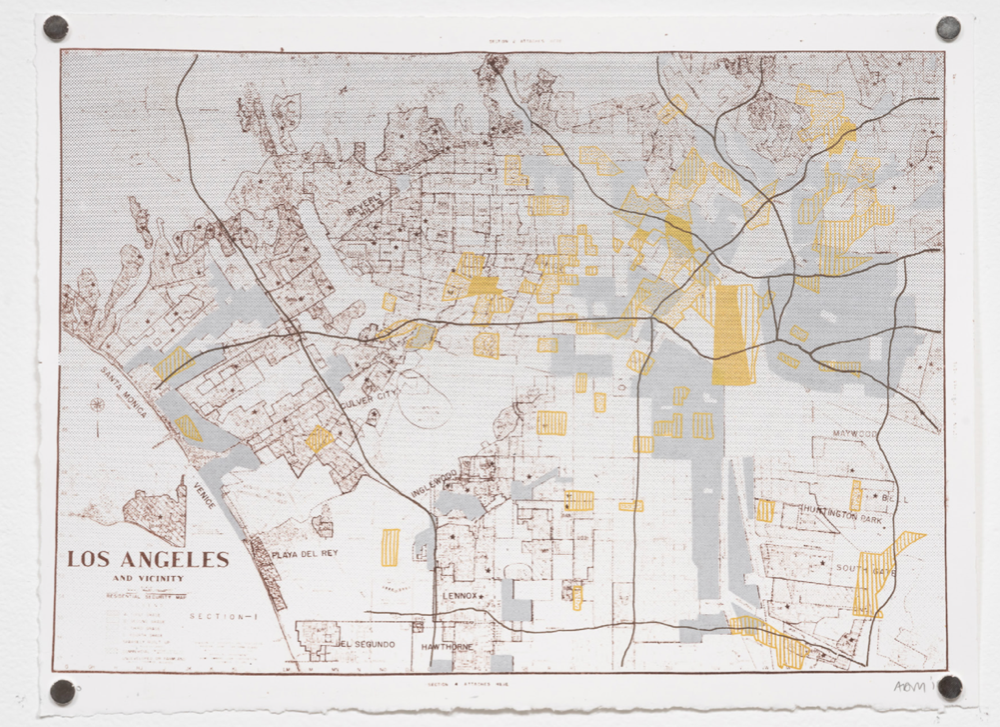
Alvaro D. Marquez, Racial Cartographies, Photolithography & Serigraphy, 11" x 15",
2018.
Alvaro D. Marquez
Rancho los Nietos was one of the largest land- holdings in colonial Los Angeles, stretching from what we now call Whittier and Downey, to Santa Ana, Compton, and Long Beach. Though it was eventually subdivided by heirs into several smaller ranchos (like Los Cerritos, Los Alamitos, Santa Gertrudes, and Los Coyotes) this vast space was mapped in 1834 for Abel Stearns, an East Coast land baron and cattle rancher who became a naturalized Mexican citizen prior to US annexation of the Southwest.
A drawing of this pen and ink map has been reproduced on this wall (center), along with the abstract geographical shapes of the ranchos into which Los Nietos would later be split (right and left of map). This site-specific installation, in conjunction with the works on paper, serve as an effort to highlight the centrality of displacement and containment in the economic development of the Los Angeles Basin, and underscore the ways in which current issues around gentrification and homelessness are, in part, rooted in the colonial encounter. It was at this moment that land became privatized and traded as a commodity, something foreign to indigenous populations who saw themselves as stewards of the land in a reciprocal relationship.
From the original Tongva, Acjachemen, and Luiseño people, whose land was first taken
in the forming of these ranchos, to recent concerns about gentrification in working-
poor communities, displacement is, and
has been, a central factor in the growth and development of the greater Los Angeles
area.
Álvaro D. Márquez is a printmaker and educator based in Los Angeles county. He is originally from the working class immigrant community of East Salinas, California. His artistic practice engages questions of history, visual culture, and displacement. He holds a BA in US History from Brown University and an MA in American Studies and Ethnicity from the University of Southern California, and is currently pursuing an MFA in Printmaking at California State University, Long Beach.
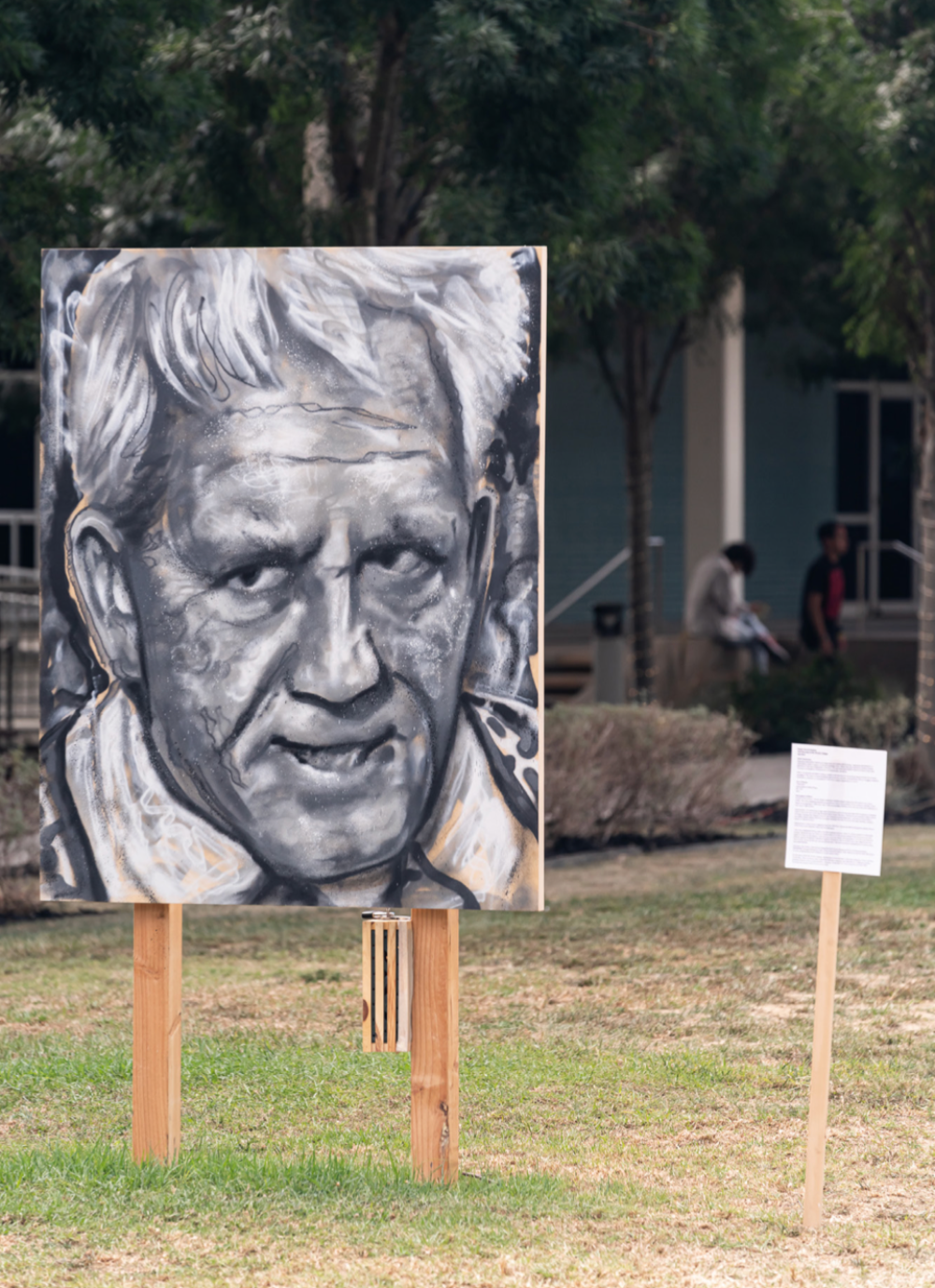
Sergio Daniel Robleto, Treason, Spraypaint on Wood, 60" x 48", 2019.
Sergio Faniel Robleto
You probably aren’t familiar with the work of Sergio Daniel Robleto because he has intentionally avoided you. His situationist approach to making art removes him from the prevalent norm where artists can be easily distinguished by the ascribing of an aesthetic. He asserts that an artist must not be constrained by those conventions associated with typical artist practices where artists showcase a distinct style. Instead the process of creation should involve selecting the appropriate instruments, techniques, and environments intended for the dynamic and content of the situation. This in turns is why his work is not something you can immediately put a name to.
Over the span of the past 16 years various galleries associated with multiple genres have exhibited his work ranging from conceptual(Shoshana Wayne Gallery, Santa Monica), figurative(Stay Gallery, Downey, CA), text-based(Happy Gallery, Los Angeles), representational(Blue Bird Art House, Whittier, CA), phenomenology(Ridenbaugh Gallery, Moscow,ID), abstract(Heritage Wine COmpany, Pasadena), illustration(Ontario Museum of History and Art), Chicano(Espacio 1839), pop surrealism(Cannibal Flower Gallery, Los Angeles), installation art, and even graffiti(Crewest Gallery, Los Angeles).
Although a native to Los Angeles he received his BFA from the University of Idaho in 2003. Upon graduating he immediately began exhibiting work along side Mexican artists like Rufino Tamayo and Vladimir Cora with the Latin Art Brokers Gallery in East Los Angeles. Since then, he has continued to exhibit his works in solo and group exhibitions, and done work for various clients ranging from Miramax, Red Bull, Newman Marcus, ESPN, Sprite, and more. His most recent body of work has consisted of creating multiple murals in various locations in Southern California including Long Beach, Los Angeles, Chino, Palm Springs, San Diego, Rampart Village, El Sereno, Compton, Nickerson Gardens, Downey, Boyle Heights, El Monte, Whittier, and more.
Most notable amongst those murals is the work he is doing in the community of Boyle
Heights. It was at this particular point in his career where the responsibility of
being the voice of the community became more prominent than ever. With the constant
threat of gentrification and the actual displacement of many locals, the presence
of a mural became a potential threat due to the perception of murals often being an
indicator of the first signs of gentrification in a community.
To avoid this Sergio made it a point to interview multiple local community members
for all of
the 5 murals he has completed so far within the community. The result has been completely
positive and instead of the murals feeling like a threat they have become part of
the community and its sense of civic pride. Most notably, is the mural on 1st and
State street that commemorates the prolific mural work of Chicano artists Wayne Healy
and David Botello, also known as the East Los Streetscapers.
He is currently in the process of planning future projects in Boyle Heights including Euclid Elementary, Blueberry Hill, White Memorial, and Espacio 1839.
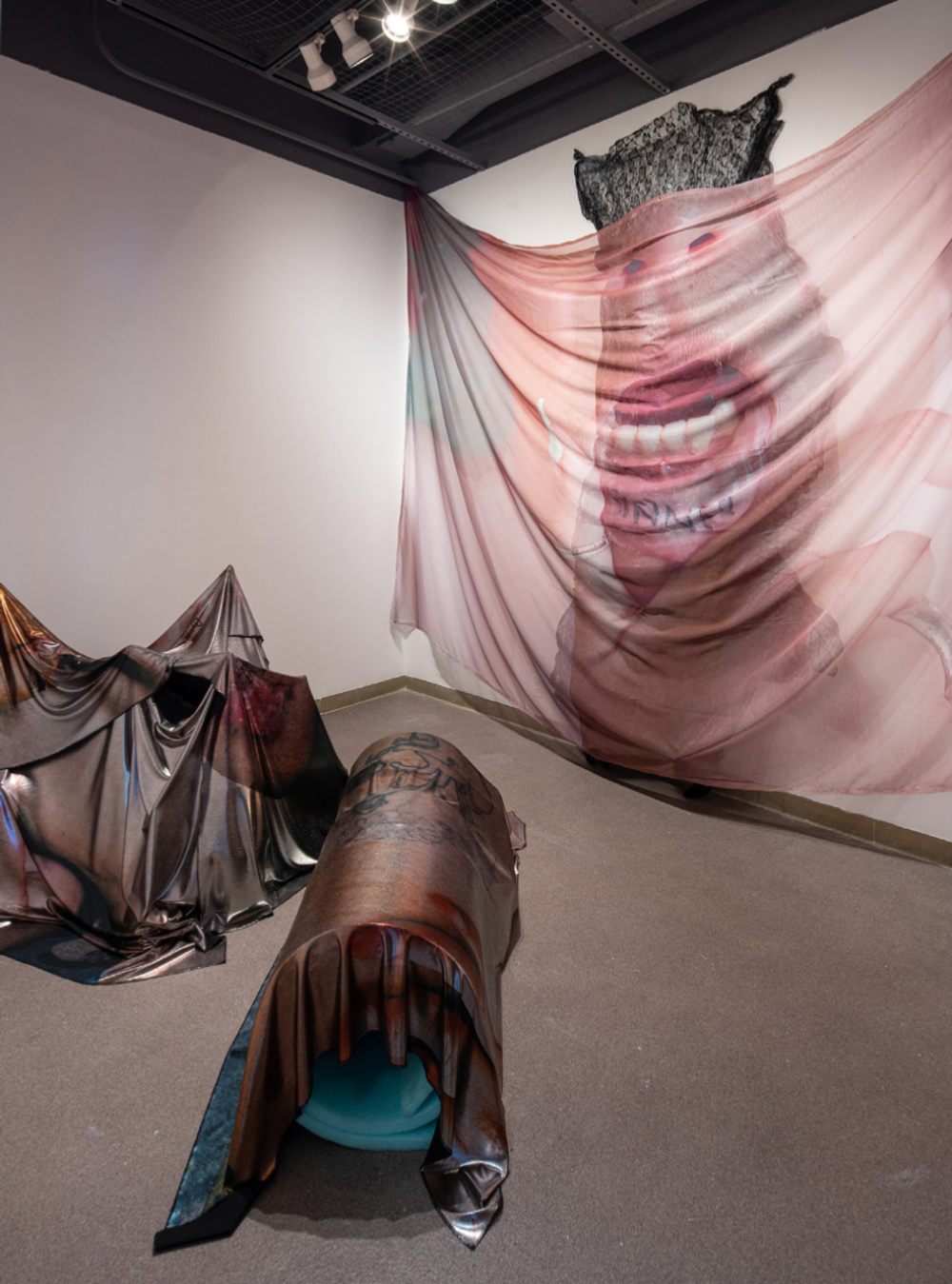
Jakline Romine, Living With SCI (Showing My Inner Sinner) Mixed Media Installation,
96" x 120", 2019.
Jakline Romine
Living With SCI, is a documentation of the trauma that happens to my body in areas
that have become paralyzed, that I can not feel like an able-bodied person. Living
with a spinal cord injury has many problems and many pitfalls but one of the biggest
visual and physical experiences of this affliction is not having normal sensation.
So my body
can experience pain that my brain cannot understand and the skin and nails get ripped
off of my body without my knowledge. So I document this phenomenon and try to show
the beauty and disgust within this experience. I have taken these images and printed
them on non-photographic materials. Using digital sublimation on chiffon and iridescent
fabric, I create a pliable image that hangs, droops, sags, and folds in unconventional
ways that brakes the language between image and object hood. To complicate the situation
I create fabric sculptures that are mounted behind or lay beneath the image that creates
an abstraction of the content and the context of the image that breaks reality and
the expected. Which allows the space I’ve created to float between installation, sculpture,
and photography on top of a fabric scape that pushes photography into the third dimension.
Jaklin Romine was born in Burbank, Califor- nia, and currently lives in East Los Angeles. She studied Studio Arts at Cal State LA, where she was selected to be part of the Luckman Project. She then showed in galleries around Los Angeles, such as Gallery 825, and Avenue 50, before completing her Masters of Fine Arts at CalArts. Since graduating Romine was selected to participate in the Emerging Artist 2018 show at the Barnsdall Art Park, Los Angeles, CA. Other exhibitions include New Women Space, New York, NY; Navel, Los Angeles, CA; and Night Gallery, Los Angeles, CA. Romine has lectured on her work at the Torrance Art Museum, Torrance, CA; Cal Arts, Valencia, CA as part of their ArtChangeUS: Arts in a Chang- ing America five year initiative; and The Main Museum of Los Angeles, CA. Her work has been featured in multiple issues of Sacha Bau- mann’s broadsheet, Full Blede and at the 2019 she was featured on the cover in conjunction with her participation in Continuant, a group show at Noysky Projects, Hollywood, CA. She received the Rema Hort Foundation 2019 Emerging Artist Grant which assisted her in creating her latest body of work that was shown in her first solo show, Why bring me flowers when I’m dead ? when you had the time to do it when I was alive/Living with SCI, PSLA, Los Angeles, CA.
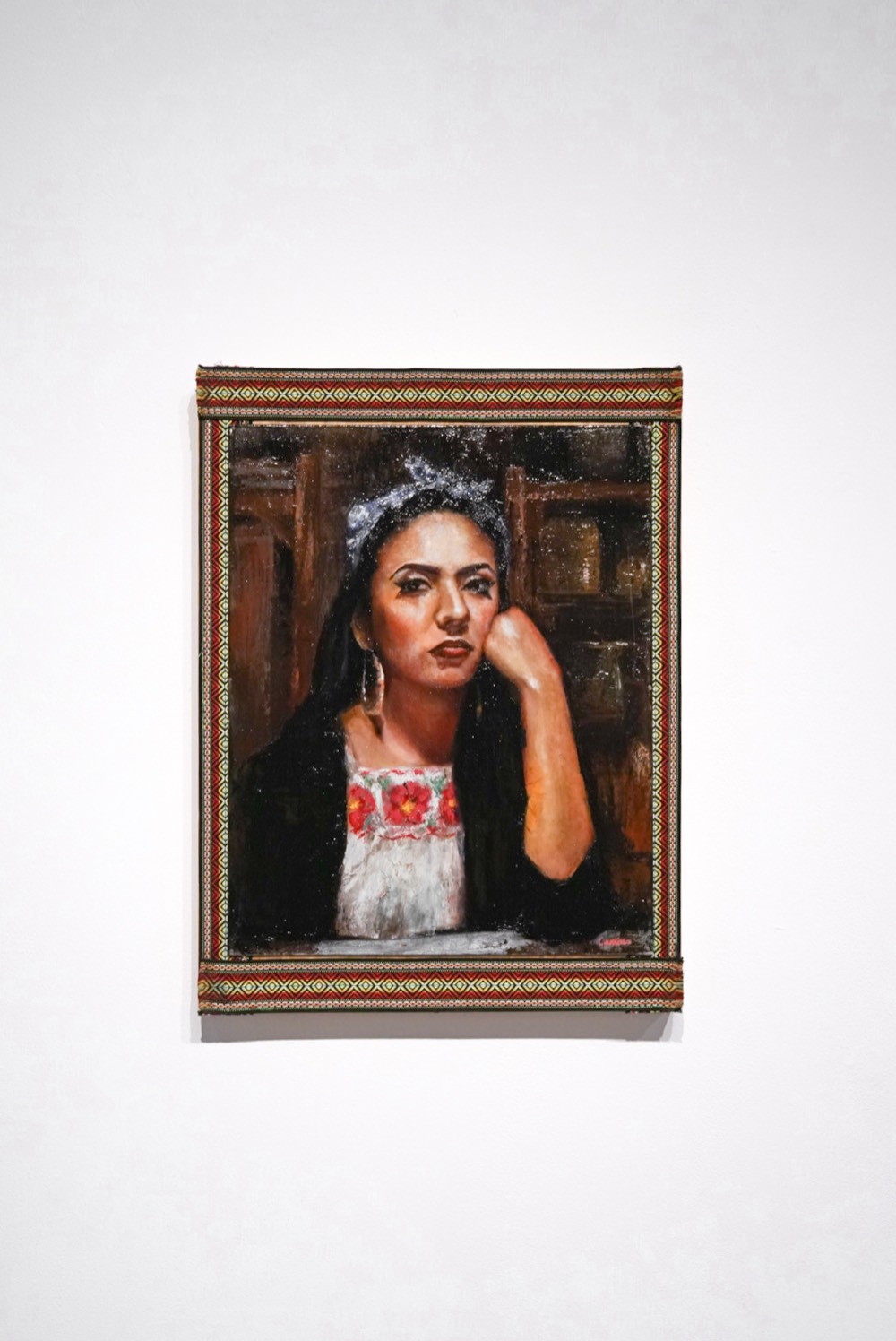

Stay Connected